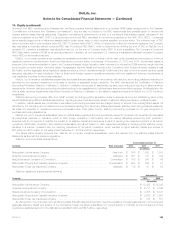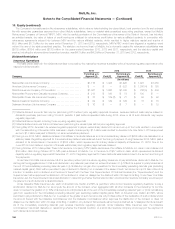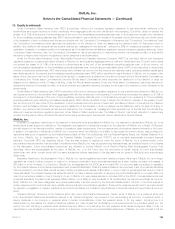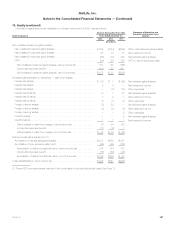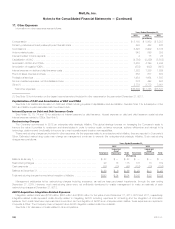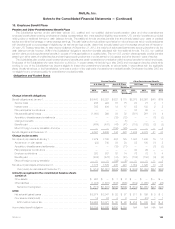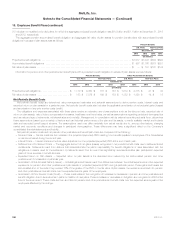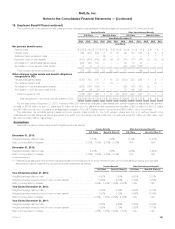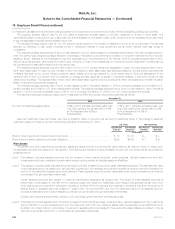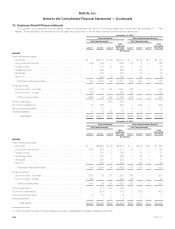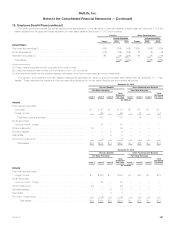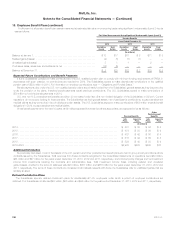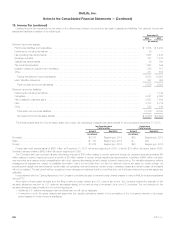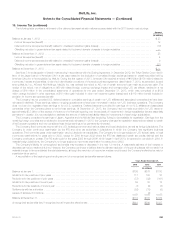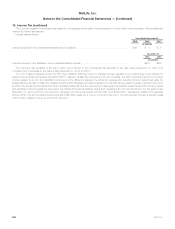MetLife 2013 Annual Report Download - page 200
Download and view the complete annual report
Please find page 200 of the 2013 MetLife annual report below. You can navigate through the pages in the report by either clicking on the pages listed below, or by using the keyword search tool below to find specific information within the annual report.
MetLife, Inc.
Notes to the Consolidated Financial Statements — (Continued)
18. Employee Benefit Plans (continued)
(1) Reflects those assumptions that were most appropriate for the local economic environments of each of the Subsidiaries providing such benefits.
The weighted average discount rate for the U.S. plans is determined annually based on the yield, measured on a yield to worst basis, of a
hypothetical portfolio constructed of high quality debt instruments available on the valuation date, which would provide the necessary future cash flows
to pay the aggregate projected benefit obligation when due.
The weighted average discount rate for non-U.S. pension plans is based on the duration of liabilities on a country by country basis. The rate was
selected by reference to high quality corporate bonds in developed markets or local government bonds where markets were less robust or
nonexistent.
The weighted average expected rate of return on plan assets for the U.S. plans is based on anticipated performance of the various asset sectors in
which the plans invest, weighted by target allocation percentages. Anticipated future performance is based on long-term historical returns of the plan
assets by sector, adjusted for the Subsidiaries’ long-term expectations on the performance of the markets. While the precise expected rate of return
derived using this approach will fluctuate from year to year, the policy of most of the Subsidiaries’ is to hold this long-term assumption constant as long
as it remains within reasonable tolerance from the derived rate.
The weighted average expected long-term rate of return for the non-U.S. pension plans is an aggregation of each country’s expected rate of return
within each asset class. For each country, the rate of return with respect to each asset class was developed based on a building block approach that
considers historical returns, current market conditions, asset volatility and the expectations for future market returns. While the assessment of the
expected rate of return is long-term and not expected to change annually, significant changes in investment strategy or economic conditions may
warrant such a change. The expected rate of return within each asset class, together with any contributions made, are expected to maintain the plans’
ability to meet all required benefit obligations.
The weighted average expected rate of return on plan assets for use in that plan’s valuation in 2014 is currently anticipated to be 6.24% for U.S.
pension benefits and 5.64% for U.S. other postretirement benefits. The weighted average expected rate of return on plan assets for use in that plan’s
valuation in 2014 is currently anticipated to be 3.01% for non-U.S. pension benefits and 7.25% for non-U.S. other postretirement benefits.
The assumed healthcare costs trend rates used in measuring the APBO and net periodic benefit costs were as follows:
December 31,
2013 2012
Pre-and Post-Medicare eligible claims .......... 6.4% in 2014, gradually decreasing each year
until 2094 reaching the ultimate rate of 4.4%
for Pre-Medicare and 4.6% for
Post-Medicare.
7.8% in 2013, gradually decreasing each year
until 2094 reaching the ultimate rate of 4.4%
for Pre-Medicare and 4.6% for
Post-Medicare.
Assumed healthcare costs trend rates may have a significant effect on the amounts reported for healthcare plans. A 1% change in assumed
healthcare costs trend rates would have the following effects as of December 31, 2013:
U.S. Plans Non-U.S. Plans
One Percent
Increase One Percent
Decrease One Percent
Increase One Percent
Decrease
(In millions)
Effect on total of service and interest costs components ................................ $ 16 $ (13) $— $—
Effect of accumulated postretirement benefit obligations ................................ $235 $(193) $ 1 $ (1)
Plan Assets
The pension and other postretirement benefit plan assets are categorized into a three-level fair value hierarchy, as defined in Note 10, based upon
the significant input with the lowest level in its valuation. The following summarizes the types of assets included within the three-level fair value hierarchy
presented below.
Level 1 This category includes separate accounts that are invested in fixed maturity securities, equity securities, derivative assets and short-term
investments which have unadjusted quoted market prices in active markets for identical assets and liabilities.
Level 2 This category includes certain separate accounts that are primarily invested in liquid and readily marketable securities. The estimated fair value
of such separate account is based upon reported NAV provided by fund managers and this value represents the amount at which transfers into
and out of the respective separate account are effected. These separate accounts provide reasonable levels of price transparency and can be
corroborated through observable market data.
Certain separate accounts are invested in investment partnerships designated as hedge funds. The values for these separate accounts is
determined monthly based on the NAV of the underlying hedge fund investment. Additionally, such hedge funds generally contain lock out or
other waiting period provisions for redemption requests to be filled. While the reporting and redemption restrictions may limit the frequency of
trading activity in separate accounts invested in hedge funds, the reported NAV, and thus the referenced value of the separate account,
provides a reasonable level of price transparency that can be corroborated through observable market data.
Directly held investments are primarily invested in U.S. and foreign government and corporate securities.
Level 3 This category includes separate accounts that are invested in fixed maturity securities, equity securities, derivative assets and other investments
that provide little or no price transparency due to the infrequency with which the underlying assets trade and generally require additional time to
liquidate in an orderly manner. Accordingly, the values for separate accounts invested in these alternative asset classes are based on inputs
that cannot be readily derived from or corroborated by observable market data.
192 MetLife, Inc.



